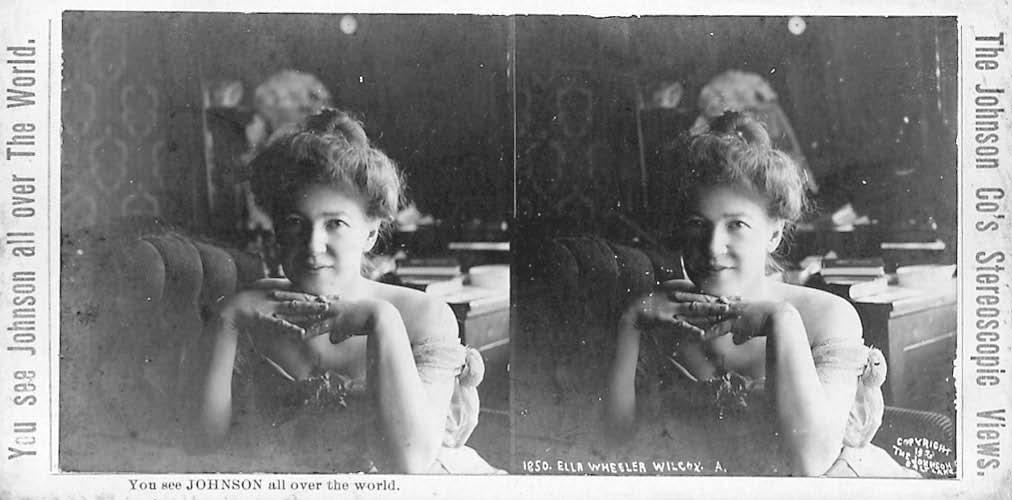
31 minute read
“Appreciating a Pretty Shoulder”: The Risqué Photographs of Charles Ellis Johnson
“Appreciating a Pretty Shoulder”: The Risqué Photographs of Charles Ellis Johnson
By DANIEL DAVIS
Housed in the collections of the Special Collections and Archives at Utah State University is an intriguing set of risqué photographs dating roughly from 1890 to 1910. Some of the images are stereo-views or cabinet card portraits of burlesque actresses either in tights or displaying bare necks, shoulders, and upper bosoms. Other photographs in the collection are even more suggestive with women undressing, lounging about with dresses that reveal their thighs, wearing body suits, and removing one-another’s clothing. By today’s standards they are more comical than pornographic. Considering the conventions of the time, however, especially in conservative, turn-of-the-century Utah they are quite shocking.

Stereo-view of poet and actress Ella Wheeler Wilcox, 1903.
UNLESS OTHERWISE INDICATED, ALL PHOTOGRAPHS ARE FROM SPECIAL COLLECTIONS OF UTAH STATE HISTORY
In a time before movies and television, acting companies toured the country to perform before packed theater houses and it was common for local photographers to capitalize on this popularity. The entertainment ranged from high-brow productions of Shakespeare to “low brow” burlesque with attractive women in tights as the main attraction. Men bought suggestive images of the actresses as part of the show. The risqué images at Utah State University are fairly conventional for their time and are intriguing not for their content, but because the photographer was Charles Ellis Johnson. During his years as a professional photographer in Salt Lake City from about 1890 to 1916 Charles made images of attractive women a specialty, but he was not the first to introduce risqué images to Utah. Risqué photography is almost as old as the medium itself, and there were, no doubt, more explicit images sold in Salt Lake City’s saloons and taverns around or even before 1900. 1 Although he was the only major Mormon photographer selling risqué photographs, they are also not unique or ground breaking. His images reflect the general trends towards greater nudity and a more voyeuristic depiction of women from the 1890s to the 1900s to a surprising degree.
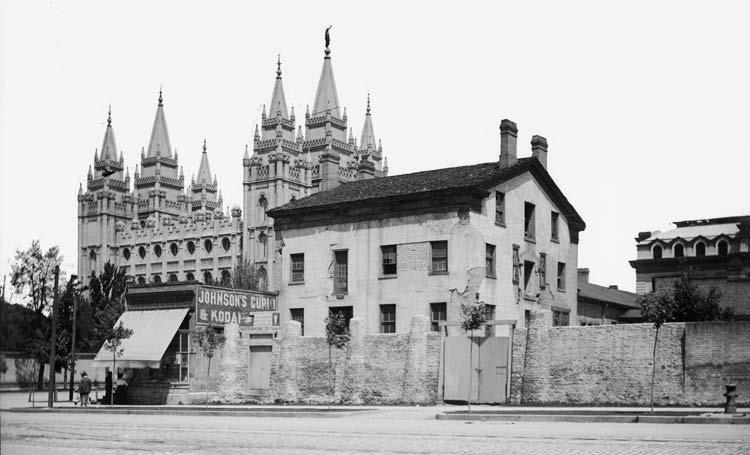
Johnson's photography shop located on the corner of Main and South Temple. c. 1910.
UNIVERSITY OF UTAH SPECIAL COLLECTIONS
What is intriguing is that Johnson arguably became the unofficial “Church Photographer” in the 1890s. He photographed the Salt Lake City Temple dedication, went to the Chicago World’s Fair in 1893 with the Mormon Tabernacle Choir (and to San Francisco in 1896), shot group portraits of the First Presidency and the Quorum of the Twelve, and sold reprints of older Brigham Young photographs. His advertisements as well heavily pushed the Mormon angle. 2 Far from being a part of Salt Lake City’s “underbelly,” Charles Johnson was a successful local businessman from a pioneer LDS family who married a daughter of Brigham Young.
Johnson did, however, have a connection with burlesque and vaudeville theater and had photographed hundreds of actors and actresses from the local Salt Lake theater as well as national touring groups. One of those women, Ella Wheeler Wilcox, wrote to him in 1903 from the Brown Palace Hotel in Denver, Colorado. Johnson’s recent photographs of Wilcox revealed her bare neck, shoulders, and upper bosom, which was fairly typical for many of his portraits. 3 In response to objections raised by one man over the impropriety of her photographs, Wilcox wrote: “Tell the gentleman... that I am sorry he should object to a little bit of neck. He probably had a surfeit of necks in his plural wives, and it gave him a sort of physical indigestion. You see what a terrible thing polygamy is sometimes, when it unfits a man for appreciating a pretty shoulder.” 4
This example highlights the inherent tension between those who objected to Johnson’s images (as well as his Mormon heritage with its aversion to indecency), and to his continued appreciation of “pretty shoulders” as demonstrated through his photography. One wonders just why Johnson decided to take this path. It is doubtful that financial rewards justified his behavior given the relative scarcity of his risqué images today and given his other successful businesses. A more credible explanation lies in an analysis of the man himself. For instance, at first glance Johnson looks much like a typical, active member of The Church of Jesus Christ of Latter-day Saints. A closer examination, however, reveals a much more complicated person who, while not formally apostatizing, completely dissociated himself from the LDS church. His story illustrates not only how Utah’s visual culture of the female form changed around 1900, but also how one man maintained a delicate balance between his interest in the emerging sexuality of the world of theater and photography with his public persona as a Mormon businessman.
When Johnson began his photography business about 1890 it was undoubtedly not to create risqué images. He and his wife, Ruth Young, moved to Salt Lake City in 1882 from St. George where they had met during Brigham Young’s winter sojourns. Because of his background working with his father, Joseph Ellis Johnson, manufacturing homemade medicinal remedies, Charles started to work as a druggist with ZCMI. Although he described this as a “good job,” a more lucrative arrangement with Parley P. Pratt (the son of murdered apostle Parley Parker Pratt) operating a drug store presented itself. At that point in his life Johnson needed the money. His father died of pneumonia in Arizona, and his younger brothers and sisters as well as his mother were forced to relocate to Salt Lake City. Johnson was just twenty-five years old when he shouldered the responsibility of becoming a surrogate father to his younger brothers and sisters. 5

Cabinet card portrait of Franc Madigan with clothing from the burlesque play, The Black Crook, c. 1893.

Sometime in 1889 or 1890 Pratt and Johnson purchased the Hyrum Sainsbury photo studio.Initially Johnson was the business manager of the studio,but he quickly became more interested in the actual photography.The national depression of 1893 would take its toll on Johnson’s three businesses (the drug store,the photo studio,and the VTR or Valley Tan Remedies which manufactured medicinal products),and it was only through incorporation that he was able to save them.Perhaps due to the depression,Sainsbury retired,leaving Johnson in control of the studio.6

Risqué stereo-view of unidentified woman, c. 1900.
The bread and butter for any local photographer during that time would have been studio portraiture and views of local interest such as buildings, monuments, celebrations, and civic groups. Charles Johnson was no different in this regard, but he also specialized in LDS material and Salt Lake City’s theater scene. He maintained an earlier interest from when he was an actor and managed the small theater in St. George. He took numerous photographs of actors and (especially) actresses who were either native to or traveling through Utah as well as theater productions ranging from school plays to burlesque productions. He was, as well, the official Utah correspondent of the New York Dramatic Mirror. 7 Just when Johnson started photographing actresses is unknown, but it was probably shortly after 1890. Because he did not leave a diary or voluminous correspondence and most of his images are not dated, a time-line is difficult to establish. Johnson advertised in the Deseret Evening News that he would, “give a special premium of V.T.R. gold medal to the prettiest girl between the ages of 15 and 30 years present on the Fair grounds....” 8 This brief notice shows that at least by 1894 he was looking for attractive women presumably to photograph. In one case he photographed Franc Madigan in 1893 with the clothing she wore for the burlesque show, “The Black Crook.” In all likelihood he began his foray into risqué photography through his connection with burlesque theater. 9
Burlesque featured women doing and saying shocking things. They smoked, they drank, they wore men’s clothing, and they said and did things that earned them the wrath of polite society. The clothing they wore was considered scandalous for the time, and carte-de-visité and cabinet card images of burlesque actresses in this clothing were extremely popular. 10 It is important to note, however, that burlesque photographs might show an actress in her scandalous clothes, but not nude. Nudity in American stereoviews is rare before 1900. For example one photo from the early 1890s of a woman in a form fitting “mummy-suit” is bold in displaying her hourglass figure, but only includes her bare shoulders and neck. Johnson’s risqué stereo-views are similar to other depictions of “young ladies in scanty clothes, showing stockinged legs, bare backs and the tops of their breasts.” 11
Sometime in the mid to late 1890s Johnson started to publish stereographic “series” under his label. These series consist of several images that, when viewed chronologically, told a story. One series makes reference to the Spanish-American War, so these images date to around 1898 or 1899. This series does not show nudity. In it a woman is waiting for her husband to return from the war. Her “husband” turns out to be a woman dressed as a man. He is summoned back to the war, leaving her devastated (although not before they can embrace and kiss). Johnson was following conventions by creating a story or series of scenes that often had sexual overtones. In another series he shows a young maid displaying her stockings and thighs as she lounges about her employer’s home reading Vanity Fair instead of working. “Missus is out — who cares” is written on the image. In another set a man points a gun at an elaborately dressed woman. The woman’s money is hidden next to her garter, of course, but the woman manages to grab the gun while the man is removing the money, and she is now in charge. Judging by the dress these images were probably taken in the late 1890s. 12
Johnson’s risqué photography also used elements of orientalism. He attended the 1893 World’s Fair, where suggestive displays of the harem and the strip-tease/belly dance were introduced to burlesque theater. Some of Johnson’s photographs show women lounging in an oriental setting wearing oriental clothing. In one stereoview a young lady asks, “Will you smoke the Nargileh?” In others she herself is smoking the Nargileh, dancing, or looking flirtatiously into the camera (the caption reads: “The Sultan’s Favorite”). 13 The idea that these photographs might have appealed to viewers in postmanifesto Utah by pushing the sexuality of a polygamous harem is interesting to consider, but difficult to prove.
After the turn of the century Johnson’s images started to show more nudity. Based on the wording, color, font style, and verso inscription there are thirteen different styles of stereo-views in the collection at Utah State University. Six stereo-views representing four different styles have copyright dates of either 1903 or 1904. Assuming that the same style of stereo-view was not used over a period of years (and given the fact that the same models show up in different styles) we can say that the most suggestive images come from that time period. For instance, one set shows a woman in a full-body, transparent outfit. Perhaps the most shocking series (with the same stereographic style as a 1904 copyrighted image) depicts two women in vaguely oriental costume who are undressing one another. These images do not have the awkward embraces, or the girlish, fun-loving spirit of the Spanish-American War series. The two women are touching one another’s bare flesh in a sensual way. 14
The most brazen example of nudity in a stereo-view is from an image labeled, “Artistic reflections.” 15 For Charles there seemed to be an overlap between artistry and commercialism. During this time “artistic” photographs were large-format (8 x 10 inches or larger) and carefully produced, not by a darkroom technician, but by the photographer himself. Johnson did make at least one large-format nude study using his 18 x 22 inch camera in 1902, so this image falls within what could have been considered artistic. 16 The nude study model, however, also appears in several risqué stereo-views, mass reproduced images designed for commercial sale.

Stereo-view of two women, one in Spanish-American War uniform, c. 1898.

“Naughty Maid,” risqué stereo-view, c. 1903.
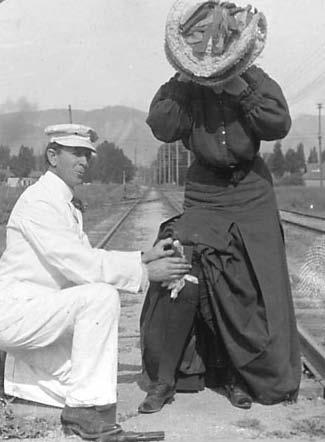
Stereo-view of man supposedly stealing money from a rich woman, c. 1895.

Stereo-views of women in "Middle-Eastern" clothing. c. 1903.


Stereo-view of art model, 1904.
Studio owners commonly hired out much of the daily photography work. There is, however, some intriguing evidence that Johnson took many of the photographs himself. A relative inquired in a 1897 letter, “Have you made many Actresses photos lately?” In 1903 he wrote: “I went to the Grand Opera House to see Geo. Ade’s Opera, The Sultan of Sulu. It is only fairly good - not near as many funny sayings as you would suppose, but the costumes and pretty girls are all right.” In another letter written from Jerusalem he wrote about photographing Middle Eastern women: “One or two pretty girls have shown me their faces when they were quite sure there was no rubber neckers around. They are just as [bashful] about showing their faces as our girls are to be seen half dressed.” 17
Although there is no evidence that Charles was prosecuted, based on Utah’s indecency statutes, some of his risqué images were probably illegal. Penal Code 4247 in the 1898 Revised Statutes of Utah reads in part: “Every person who willfully and lewdly either—Writes, composes, stereotypes, prints, publishes, sells, distributes, keeps for sale, or exhibits any obscene or indecent writing, paper, or book; or designs, copies, draws, engraves, paints, or otherwise prepares any obscene or indecent picture or print; or moulds, cuts, casts, or otherwise makes any obscene or indecent figure;—is guilty of a misdemeanor.” The word “stereotypes” surely is a reference to stereoviews and given the standards of the time some of his images would have been considered obscene.
It is hard to imagine that the LDS church leaders would have approved. In 1899 LDS Apostle Rudger Clawson commented upon the possible sale of the Salt Lake Theater by Heber J. Grant to the LDS church:“...would prefer that the church [does] not buy it, as it is so difficult to control the character of performances given there, and the church would many times be exposed to adverse criticism.” 18 LDS President Joseph F. Smith later expressed this concern about the “performances given” in the theater in 1911:
Smith also did not hesitate to express his thoughts on 1913 clothing styles: “In my sight the present day fashions are abominable, suggestive of evil, calculated to arouse base passion and lust, and to engender lasciviousness, in the hearts of those who tolerate them. . . . God have mercy on our girls and help them dress decently!” 20

Stereo-view of woman in semi-transparent clothing, c. 1903.
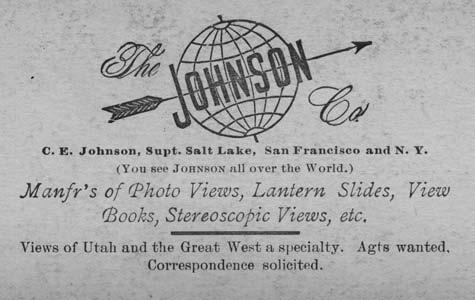
Verso side of typical Johnson stereo-view, c. 1903.
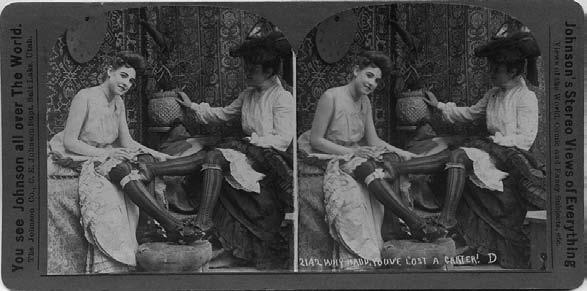
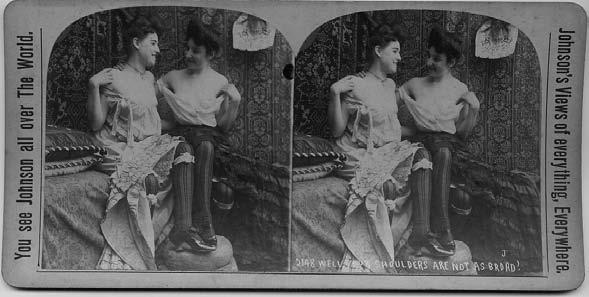
President Smith was responding to the increasing presence of attractive women wearing less and less in vaudeville plays, musical comedies, and all female revue shows. Surprisingly, these shows played in the more respectable theaters such as the Salt Lake Theatre and the Capitol Theatre. Judging by theater programs and advertisements, the first all-female “beauty chorus” appeared in Salt Lake City vaudeville in 1907 (although it might have been earlier). After 1907 the presence of shapely women with fewer clothes became more pronounced. By 1912 vaudeville and musical comedies in Utah used the all-female revue with the main attraction of women in various states of dress and undress. The trend throughout the 1910s was towards more women and less clothes. By the 1920s blatant nudity appears in the advertisements. 21 By the early 1920s the risqué images Johnson sold were more acceptable as provocative images of the female form had become a fixture in American popular culture.
Johnson’s images, however, came out long before the 1920s, and many questions still remain unanswered. Why did he test the limits of propriety after the turn of the century? Did the stern-faced LDS church leaders who had their portraits taken in his studio know about these images? Was Johnson privately reprimanded or shunned by his peers? Given the history of the LDS church and lewdness what led Johnson down this path?
It is tempting to look at Johnson’s father, Joseph, for answers. For instance, in 1905 Joseph’s brother Benjamin F. Johnson wrote a letter in response to Charles’ question about the fate of early family historical documents: “Your questions as to what I will do with the few records I may have to leave... to me is a subject of grave thought. For I have no one around me to whom such a care would be submitted and were you at heart a true Latter Day Saint... But I fear you are only a [Mormon] and our woods are getting so full of them that I fear the Lord will soon turn his Bears Loose unless they repent...” In the same letter Benjamin implicitly made a connection between father and son: “...almost the last words of your father to me was ‘Oh! If I could live just a few years yet I would religiously get out of my old life and get up where you are for I can now see so plainly what I have lost.’ His mind seemed to open and he seemed greatly changed in his feeling and in his faith in Gospel [Ordinances]. But I knew it was then too late.” 22
The like-father-like-son argument can easily be overstated. Benjamin Johnson was, after all, the family nag when it came to religious concerns. It is interesting to note, however, that Joseph’s relationship with the LDS church may have been a bit rocky or, at the very least, fairly casual. The elder Johnson began life on April 28, 1817, in Chautauqua County, New York. He came from a Presbyterian family of sixteen siblings, all of whom received biblical instruction from their mother Julia. In 1831 the family, except the father Ezekiel, converted to The Church of Jesus Christ of Latter-day Saints. In 1833 they moved to Kirtland, Ohio. After the fall of Kirtland in 1838, the family moved to Springfield, Illinois, and Joseph became a schoolteacher. In 1840 the family moved to Nauvoo and Joseph married Harriet Snider. In 1846 he and Harriet moved to Montrose, Iowa. To make ends meet he opened a store, which manufactured his homemade medicinal remedies. Two years later he moved again, this time to Kanesville (later renamed Council Bluffs) and opened another store, became the postmaster, started a small farm, and edited a newspaper. He also entered into plural marriage with Hannah Maria Goddard. In 1854 Joseph moved across the Missouri River to the fledgling town of Omaha and started another newspaper. 23
Joseph and an English girl Eliza Saunders probably met during one of Joseph’s trips to St. Louis to purchase merchandise for his store in Council Bluffs. Eliza became Joseph’s third wife in 1856.This marriage was initially kept secret from the public (to avoid prosecution in Nebraska), from Eliza’s parents (they didn’t approve of plural marriage), and also from Joseph’s first two wives. Eventually, however, he was brought up on charges in Iowa. His legal woes were stalled with the help of gentile allies, and of his political aspirations, business problems, and delicate legal situation convinced him to move to Salt Lake City. 24 Young Charles was only three years old when he and his mother made the trek in 1860. Joseph did not travel with them, and he initially seemed reluctant to follow. He and his first two wives, however, joined them soon afterward. Roughly a year after coming to Salt Lake City, the extended family once again moved, this time to Spring Lake near Payson, Utah. Joseph operated a printing press, nursery, manufactured medicines, and started a store. In 1865 the family moved even further south to the warmer climate in St. George. 25
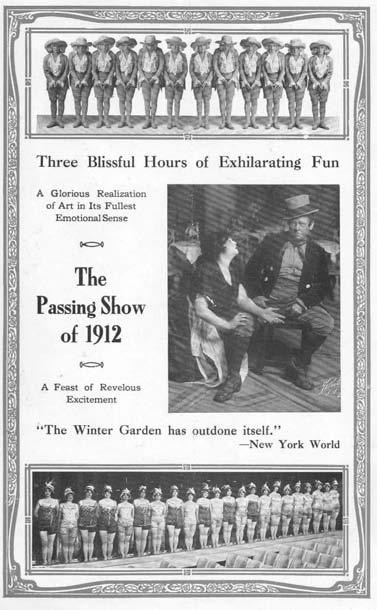

Theater program for the musical comedy "The Passing Show of 1912."
In St. George, Charles Johnson grew to manhood in a family that valued culture and learning. As he himself wrote, “I grew up a country boy, but one who always had the surroundings of literature, art, and gentility.” 26 But in rural St. George, he must have seemed quite cultured and intellectual in comparison to other young men of the period. He read widely, he wrote articles for his father’s paper, and he was keenly interested in both botany and anthropology. As Charles grew to manhood Joseph became increasingly dependent on him not only for his companionship, but also to run his various small businesses. Charles was a serious and hard-working boy. His early diary entries are filled with observations about the weather and document his long hours of work. 27
While Joseph was certainly involved with the LDS church throughout his life, he was also an independent man in thought and in action. He easily moved between Mormon and non-Mormon circles, and while in Iowa and Nebraska he had extensive business and political connections with nonmembers. In fact, he wished to remain in Nebraska, and his reluctance to move to Salt Lake City was noted by Brigham Young. 28 When he did move to Salt Lake City it was only for a year. Later his youngest son Rufus wrote that he, “...avoided appointment to Church offices whenever he could....” Finally, on a number of occasions he was cited for selling “spiritous liquors,” and he was a life-long user of tobacco. 29
In 1878 he once again pulled up stakes and moved his by now quite large family to the Salt River area of central Arizona. At that time Charles had little reason to move with the rest of the family. Brigham Young spent his winters in St. George and often brought along various family members including his daughter Ruth. After the two were married in 1878, they lived in Brigham Young’s St. George home while Charles cleared up remaining family business. The couple had two sons (Ellis and Jay Elliot) and a daughter (Adelia, who died in infancy), but would eventually live separate lives. Ruth along with the two boys moved to California with another man, but eventually Ellis and Jay Elliot returned to Utah. Ruth and Charles were permanently separated by 1895. 30
While Johnson never remarried, he did have an unconventional relationship with another woman. Charles probably met Minne B. Ridley for the first time after returning from a tour of the Holy Land in 1903 and 1904. 31 While on this trip Johnson left his business interests in the hands of his younger brothers who, apparently, were struggling to keep them afloat. They did hire Minnie Ridley who possessed an aptitude for business and eventually Charles and Minnie would straighten out the drug store, studio, and Kodak/Souvenir store while leaving the VTR in the hands of the brothers. Charles remained a studio photographer while Minnie ran the stores. The arrangement worked well but in 1914 Minnie passed away and Charles sold his businesses. In 1916 he moved to San Jose, California, to live with the Ridley family. 32
One of the mysteries of Charles’s life is his connection with Minnie and the Ridley family. He left his brothers and sisters, his two sons, his businesses, and the town he had lived in for more than thirty years to live with people who were nearly strangers. Furthermore, Johnson stayed with the Ridley’s (who were not LDS) for about nine years. There is at least one instance in the genealogical records of The Church of Jesus Christ of Latter-day Saints that lists Minnie, not Ruth Young, as Charles’ wife. 33 Photo historian Nelson Wadsworth describes Minnie as Charles’ sister-in-law, but this is not confirmed in the records, and all the literature (including Mr. Wadsworth’s) refers to her as “Miss Ridley.” If Minnie were only a former employee of his, it seems a bit strange that her family went to the trouble of taking him in after her death. The 1910 census indicates that Minnie lived with Charles as a “servant” even though she shows up under a different address in the Salt Lake City Polk Directory. Charles signed Minnie’s death certificate but was unable to provide information about where she was born, her father’s name, her age, or even her birthdate. 34 We do know that they were both single and had a very close business relationship. Charles seems to have considered Minnie a business partner rather than an employee and implied that her death was an important factor when he left Utah. 35 She, however, is not mentioned in the few surviving Johnson family documents. Johnson’s move to California might also be explained because, like his father, he became eager to leave Salt Lake City. Rufus wrote to his brother in 1916: “I see your heart is still set on California, and I hope you will be able to wind up the business and go there where I am sure there will be more pleasure for you than in Salt Lake.” 36 At that point in time Salt Lake City was not an inviting place for Johnson. If LDS President Smith knew about the risqué photographs surely he would not have patronized him and would have strongly discouraged others to as well.
Trying to piece together Johnson’s life by peeling back the layers of obscurity is difficult. This obscurity is even more pronounced for his risqué images and his position with the LDS church. As the earlier letter from his Uncle Benjamin shows, at least one person in the family considered him less than true to his Mormon background. What then is a “true Latter-day Saint,” and what is “only a Mormon?” Rufus, for instance, stated that Johnson was not, “a dogmatically religious person and there is little to tell of his church positions and accomplishments.” 37 Furthermore, in relating a family story in which Joseph Smith, Jr., told his grandmother Julia that all of her children would remain in the LDS church Rufus wrote, “If applied to her direct offspring the promise was fulfilled. . . . In later generations, however, there have been some, who, while not apostatizing formally have done so by their indifference to, and failure to cooperate with Church requirements.” 38
A curious, irreverent letter written by Charles while in Jerusalem reads, “The weather is not very good, and I may go to church. I can select any of the 40 there are here, and no doubt any one of them could show me the straight way to Heaven (That is if I had any desire to know). I will take the matter into consideration. (Do you think I will go?)” 39 Charles Johnson was also not part of the 1914 LDS church census, but perhaps most telling is that after his death in 1926 he was not given a Mormon burial. 40 Portraits of two very different men emerge from the records. On the one hand there was the man who had married Brigham Young’s daughter, who was a dutiful son to his mother, and a caring sibling to his brothers and sisters. This man took photographs of the Temple dedication in 1893, the Quorum of the Twelve and the First Presidency, and traveled with the Mormon Tabernacle Choir. 41 The other man shows up mostly after 1902. That man grew increasingly distant from the LDS church, photographed half-dressed women, had a relationship with another woman that his family seems strangely quiet about, and, of course, published risqué images. Johnson, however, left no diary in which he divulged his most personal thoughts. Furthermore what, if any, unofficial action the LDS church took towards the images sold by one of their own, and the consequences for Charles at a personal level, is by nature speculative.
We can speculate, however, that Charles’s father showed his son how to form a friendly but distant relationship with The Church of Jesus Christ of Latter-day Saints. Perhaps as a youth he imagined himself rising within the LDS church hierarchy.These feelings may have intensified after he married Ruth Young and moved to Salt Lake City. At some point, however, there was an internal shift in his life. He and Ruth Young separated; he became more immersed in the theater world and was exposed to young actors and actresses from outside Utah with a radically different perspective. These younger men and women (people like Ella Wheeler Wilcox) would have had a considerably more laissez faire attitude about relationships and sexuality than Johnson. After becoming a photographer he found his own artistic medium. Like other art photographers at the time he started shooting artistic nudes. From there it was a short step to risqué images sold in burlesque theaters and, perhaps discreetly in his store. Charles Johnson became, in effect, a “Social Mormon.” He did not break ties with the church completely; there was his family to consider and his businesses as well. As an image-maker he understood how important it was to build and maintain a positive image of oneself. In his position as a Salt Lake City businessman leaving under a cloud of controversy would have been disastrous. He would not have wanted to draw attention and it was not in his nature to be confrontational. His family, like other Mormon families, would have shown concern with a “wayward” member, but he maintained a patina of Mormonism rather than completely separating so, perhaps, the issue never reached a boiling point.
Although there is no historical evidence, it seems unlikely that the risqué images did not come to the attention of LDS church leaders. Historian Klaus Hansen wrote that, “in this period [around 1900] we perceive an intensified Mormon campaign for observance of the Word of Wisdom and an increase in excommunications due to sexual transgressions... sin was increasingly equated with sex, if not according to official doctrine, certainly according to the manner in which church authorities enforced compliance with sexual norms, thus shaping a quasi-official attitude.” 42 In this climate, then, Johnson would have felt himself to be even more of an outsider. After 1900 there would have been a serious split in Johnson between his Mormon heritage and the new sexual norms of the theater. Given his broken marriage, his taste for attractive women, his connection with gentile theater groups, his disinterestedness in the LDS church, and his unconventional relationship with Minnie, publishing risqué images would not have been such a difficult step.
NOTES
Daniel Davis is the photograph curator of the Special Collections & Archives Division, Merrill-Cazier Library, Utah State University.
1 See the Salt Lake Herald,March 8,1901,“The crusade against vice took yet another [shot] yesterday, when the police were ordered to close up all slot machines and all other devices in which lewd and obscene pictures were displayed ...it is well known that boys have been for long time past visiting the saloons for the sole purpose of viewing the obscene pictures in the slot machines....”
2 For example,a Johnson advertisement from 1902 (Salt Lake Theatre Programs,MSS B-44,Utah State Historical Society) prominently features his Mormon photographs of Temple Square and of LDS church leaders.An image (University of Utah,Marriott Library,Special Collections,P0110 Number 1-04-06) of Johnson’s Kodak and curio store window has nothing even vaguely burlesque.The display instead features photographs of Salt Lake City,Native Americans,and LDS church leaders.
3 Charles Ellis Johnson Photograph Collection P0011,photographs 9:108 and 109,Utah State University,Merrill Library,Special Collections & Archives (hereafter Johnson Photographs).
4 Johnson Collection, MSS 110, Box 5, folder 18,University of Utah,Marriott Library,Special Collections.(Hereafter Johnson Papers.)
5 Kate B.Carter,ed., Early Pioneer Photographers (Salt Lake City:Daughters of Utah Pioneers,1975), 270;and David Rufus Johnson, J.E.J.,Trail to Sundown:Cassadaga to Casa Grande,1817-1882,The Story of aPioneer (Salt Lake City:Deseret News Press,1961),471.
6 Johnson, J .E .J.,500
7 Johnson Papers,box 4,folder 12;“Autobiography of Charles Ellis Johnson,”four page typed transcript,File MSS 571,Special Collections & Archives,Utah State University and Nelson B.Wadsworth, Set in Stone,Fixed in Glass:The Great Mormon Temple and Its Photographers (Salt Lake City:Signature Books, 1992), 285-89.
8 Deseret Evening News,July 18,1894.
9 See Robert C.Allen, Horrible Prettiness:Burlesque and American Culture (Chapel Hill:University of North Carolina Press,1991),237;Johnson Photographs,4:029.
10 Allen, Horrible Prettiness,223.
11 Johnson Photographs,4:005;and John Waldsmith, Stereo Views:An Illustrated History and Price Guide (Radnor,PA:Wallace-Homestead Book Company,1991),140-41.
12 Allen, Horrible Prettiness,260-61;Johnson Photographs,10:21-32,9:131-136,and 9:064-074.
13 Allen, Horrible Prettiness,225-27;Johnson Photographs,9:158-159 and 10:01-02.
14 Johnson Photographs,10:09-20.Around 1903 Johnson also became much more ambitious in marketing his stereo-views.In 1903 and 1904 he visited the Holy Land and attended the St.Louis World’s Fair.In keeping with his travels the wordings on his stereo-views seem to suggest a larger audience than Utah. “You see Johnson all over The World,”and “Johnson’s Stereo Views of Everything - Views of the World, Comic and Fancy Subjects,etc.,”are inscribed on nearly every image.The inscription from the verso side of a 1903 image reads “C.E.Johnson,Supt.Salt Lake,San Francisco and N.Y Manfr’s of Photo Views, Lantern Slides,View Books,Stereoscopic Views,etc.Views of Utah and the Great West a specialty....”
15 Johnson Photographs,9:84.
16 Brigham Young University,Harold B.Lee Library,Special Collections,Photo Archives,photograph number P-6 J649 976.
17 Johnson Papers,box 4,folder 12.
18 Stan Larson,ed., A Ministry of Meetings:The Apostolic Diaries of Rudger Clawson,1898-1904 (Salt Lake City:Signature Books,1992),97.
19 Official Report of the Semi-Annual General Conference of The Church of Jesus Christ of Latter-day Saints, 1911 (Salt Lake City:The Church of Jesus Christ of Latter-day Saints,1911),5.
20 Official Report of the Semi-Annual General Conference of The Church of Jesus Christ of Latter-day Saints, 1913 (Salt Lake City:The Church of Jesus Christ of Latter-day Saints,1913),8.
21 Theatre Programs Collection,1866-1966 MSS B-44,boxes 1 and 2,Utah State Historical Society.
22 Johnson Papers,box 4,folder 11.
23 Johnson, J.E.J., 1-4,36,39,44-49,53-54,60-61,63-64,70-72,97,99,107-109,141,205,and 456-57.
24 Johnson, J.E.J. 223-26,263,273,275,297-300,and 329-30;Joseph Ellis Johnson Family, Familysearch http://www.familysearch.org.
25 “Autobiography of Charles Ellis Johnson,”file MSS 571,Special Collections & Archives,Utah State University.
26 Ibid.
27 Johnson, J.E.J., 416-17,434,445-46.Either Charles did not keep a regular diary or the diaries have been lost for these brief entries are the only examples known to the author,Johnson Papers,box 3,folders 1 and 2.
28 Johnson Papers,box 4,folder 38.In an 1856 letter from Joseph’s sister Martha,she claims to have had a conversation with Brigham Young in which he urged her to help speed along Joseph’s move to Utah.
29 Johnson Papers,box 1,folder 5 and box 4,folders 20 and 23, Johnson, J.E.J.,53,and 342-43.
30 “Autobiography of Charles Ellis Johnson,”Johnson, J.E.J., 500,and Wadsworth, Set in Stone, 282 and 284;Johnson Papers,box 5,folder 11.
31 Johnson went to the Holy Land with the imposingly named actress Madame Lydia Mary Olive Von Pinkelstein Manreouv Montford.Montford narrated popular biblical dramas acted out by native Palestinians in costume.Johnson and Montford intended to sell the views at the 1904 St.Louis World’s Fair.After spending nearly a year in Jerusalem and Palestine taking over 2,000 images,however,they discovered that Montford’s earlier contract had been repudiated and their profit would now be negligible. Johnson, J.E.J., 500;and Wadsworth, Set in Stone, 289,292,297,301,305,308.
32 “Autobiography of Charles Ellis Johnson,”and Wadsworth, Set in Stone, 289,308;“Charles Ellis Johnson,Passed Away,” Improvement Era 29 (February 23,1926):609;and Johnson, J.E.J.,501.
33 Minnie Bell Ridley,Familysearch,http://www.familysearch.org.
34 1910 United States Federal Census,Utah,Salt Lake County, Polk’s Salt Lake City Directory (Salt Lake City:R.L.Polk & Co.,1910);and State of Utah - Death Certificate, File No.1371,Series 20842,Number 45688,Utah State Archives.
35 “Autobiography of Charles Ellis Johnson.”
36 Johnson Papers,box 4,folder 12.
37 Johnson, J.E.J.,501.
38 Ibid.,80.
39 Johnson Papers,box 4,folder 21.
40 Wadsworth, Set in Stone,311.
41 Johnson Photographs,box 11.
42 Klaus Hansen,“Changing Perspectives on Sexuality and Marriage,”in Multiply and Replenish:Mormon Essays on Sex and Family,ed.Brent Corcoran (Salt Lake City:Signature Books,1994),39.







